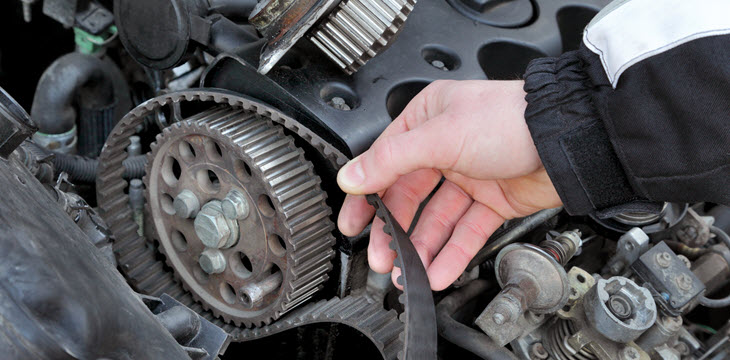Among all the various belts in your engine that are essential to your vehicle’s maintenance and performance, one of the most critical is the drive belt. It works to spin your alternator, AC compressor, power steering and most of your vehicle’s additional accessories. With the multitude of functions it serves to perform, it’s important you know how to maintain your drive belt and the signs to look for that it may be time to replace the drive belt before it can cause extensive damage under the hood of your vehicle.
The Differences Between Each Belt:
You may hear names like Serpentine, Timing and Drive belts when discussing issues under the hood of your car and while it can be confusing, knowing the specific tasks and purposes of each one will help make diagnosing issues a simpler task that helps prevent further damages.
Serpentine Belt– This is another name for the Drive Belt, if someone tells you that your serpentine belt is showing signs of wear and tear, it’s extremely important to have your vehicle looked at and repaired immediately. It’s referred to as serpentine because while the timing belt will have teeth, the serpentine belt is known for its’ smooth, rubber appearance. It’s responsible for driving the alternator, power steering and water pumps along with the air conditioning compressor and just about every accessory your vehicle may have. You may also hear it referred to as the multi-vee, poly-v or multi-rib belt depending on your auto mechanic.
Timing Belt– In your engine, the timing belt will cause the rotation of the crankshaft and camshaft so that your engine’s valves open and close during each proper intake and exhaust stroke. It can be either a rubber belt or a steel timing change. It’s one of the most important components in your vehicle and should it break it can cause catastrophic damage to your engine, rendering your car a total loss.
Signs of drive belt wearing out
Now that you know which belt serves what purpose, it’s important that you know the signs to look for that indicate that your drive belt may be wearing down. Replacing it before the event of a break is imperative to keeping your repair costs and damage to your vehicle at a minimum so if you notice any of these signs, be sure to seek out your auto mechanic as soon as possible.
- Noisy Belt– Probably the biggest sign that something is wrong is if your belt is squealing. It could be something as simple as water on the belt but it can be caused by leaking or spilled oil and if that happens, your belt will need to be replaced right away.
- Wear and Tear– Usually if your belt is going to break, it will show obvious signs of wear and tear so you can always check to see the condition of your belts. If you notice a lot of chunks missing in it or notches that seem closer and closer together, have it replaced right away before the problem gets worse. There’s no reason to take a risk and drive on a worn out belt because while it may be ok to drive like normal, at a moment’s notice it can also fail and leave you stranded while also damaging other important pieces in your vehicle.
- Power Steering/AC Issues– If you notice the AC not working, then there’s a chance something may be wrong with the drive belt, if your power steering is lost, then it’s likely the belt has broken and failed completely. If the AC is experiencing issues or not working at all, have your vehicle looked at just to be certain it’s not a belt issue as preventative maintenance is the only way to be certain that there are no issues.
- Engine Overheating– Your serpentine belt also works to help cool the engine so if your drive belt begins to fail, the water pump may not turn as well or not at all and this can lead to the engine overheating as a result. If your engine begins overheating, don’t delay and take it to a certified professional auto mechanic immediately as engine overheating can lead to breakdowns and extensive damage to the engine if left unattended to.
Final words
With so many belts under the hood, knowing what each one is responsible for and what to look for in the event of a break or wear and tear is a crucial component to preventative maintenance no matter what model or make your car is. Knowing what to look and listen for will help you extend the life of your car and keep you off the side of the road.


